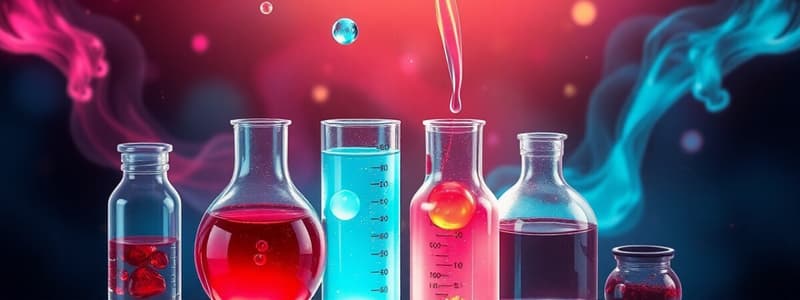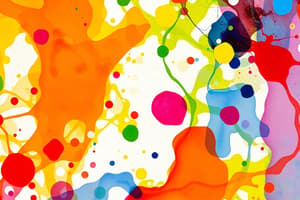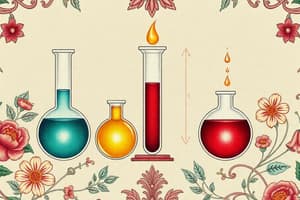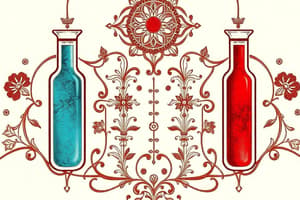Podcast
Questions and Answers
A laboratory technician tests three unknown solutions with litmus paper. Solution 1 turns red, Solution 2 turns blue, and Solution 3 shows no change. Which of the following conclusions can be reliably drawn?
A laboratory technician tests three unknown solutions with litmus paper. Solution 1 turns red, Solution 2 turns blue, and Solution 3 shows no change. Which of the following conclusions can be reliably drawn?
- Solution 1 contains hydrochloric acid, Solution 2 contains sodium hydroxide, and Solution 3 contains water.
- Solution 1 contains lemon juice, Solution 2 contains calcium hydroxide, and Solution 3 contains water.
- Solution 1 is basic, Solution 2 is acidic, and Solution 3 is neutral.
- Solution 1 is acidic, Solution 2 is basic, and Solution 3 is neutral. (correct)
An experiment involves testing various household substances with red cabbage juice to determine their acidity or alkalinity. Which observation would indicate that a substance is acidic?
An experiment involves testing various household substances with red cabbage juice to determine their acidity or alkalinity. Which observation would indicate that a substance is acidic?
- The red cabbage juice remains purple.
- The red cabbage juice turns colorless.
- The red cabbage juice turns green or yellow. (correct)
- The red cabbage juice turns blue.
A student is given three unlabelled beakers containing different solutions: hydrochloric acid, water, and sodium hydroxide. Using only litmus paper, what is the minimum number of tests the student needs to perform to correctly identify all three solutions?
A student is given three unlabelled beakers containing different solutions: hydrochloric acid, water, and sodium hydroxide. Using only litmus paper, what is the minimum number of tests the student needs to perform to correctly identify all three solutions?
- 2 (correct)
- It is impossible to identify all three solutions with litmus paper alone.
- 1
- 3
If a solution causes methyl orange to turn red, what can be inferred about the solution?
If a solution causes methyl orange to turn red, what can be inferred about the solution?
Which of the following correctly matches the substance with its expected reaction with litmus paper?
Which of the following correctly matches the substance with its expected reaction with litmus paper?
A student performs Activity 4.2 and observes that their indicator solution turns green when mixed with an unknown substance. Considering this result, what can they most reasonably conclude about the unknown substance?
A student performs Activity 4.2 and observes that their indicator solution turns green when mixed with an unknown substance. Considering this result, what can they most reasonably conclude about the unknown substance?
In Activity 4.2, why is it important to avoid open flames, sparks, or other ignition sources when using ethanol?
In Activity 4.2, why is it important to avoid open flames, sparks, or other ignition sources when using ethanol?
A researcher aims to test the acidity/basicity of several newly synthesized compounds. Which approach would provide the MOST direct and reliable initial indication?
A researcher aims to test the acidity/basicity of several newly synthesized compounds. Which approach would provide the MOST direct and reliable initial indication?
A solution turns red litmus paper blue. Which of the following statements is MOST likely true?
A solution turns red litmus paper blue. Which of the following statements is MOST likely true?
A scientist accidentally spills an unknown clear liquid on a metal workbench. To determine if it is safe to clean up, they test it with litmus paper. The red litmus paper stays red, and the blue litmus paper turns red. What should the scientist conclude?
A scientist accidentally spills an unknown clear liquid on a metal workbench. To determine if it is safe to clean up, they test it with litmus paper. The red litmus paper stays red, and the blue litmus paper turns red. What should the scientist conclude?
Flashcards
What is an indicator?
What is an indicator?
A substance that changes color depending on whether it's in an acidic or basic environment.
Acids do what to litmus paper?
Acids do what to litmus paper?
Turns litmus paper red.
Bases do what to litmus paper?
Bases do what to litmus paper?
Turns litmus paper blue.
What happens to litmus in a neutral environment?
What happens to litmus in a neutral environment?
Signup and view all the flashcards
Acid vs. Base
Acid vs. Base
Signup and view all the flashcards
Litmus paper in base
Litmus paper in base
Signup and view all the flashcards
Litmus paper in acid
Litmus paper in acid
Signup and view all the flashcards
Neutral substance
Neutral substance
Signup and view all the flashcards
Indicators
Indicators
Signup and view all the flashcards
Is water acidic, basic, or neutral?
Is water acidic, basic, or neutral?
Signup and view all the flashcards
Study Notes
- Three beakers in the figure appear the same but contain different substances.
- One contains water, one contains acid, and one contains the base.
- Adding two to three drops of an indicator helps determine what each beaker contains.
- Indicators are substances that change color in acidic or basic environments.
- Substances from plants like carrots, leaves, flowers, fruits, cranberries, red beets, and red cabbage can be used as indicators.
- Three types of indicators are commonly used in the laboratory: phenolphthalein (colorless), methyl orange (orange), and litmus (blue, red, or violet).
Litmus Paper
- Litmus paper is a common indicator used for determining acids and compounds
- If blue litmus paper turns red in a solution, the solution is acidic.
- The litmus paper will turn blue If litmus paper turns blue in a solution, then the solution is basic.
- Litmus paper does not change color in neutral environments.
- Water can be considered neutral, as it is neither acidic nor basic.
- Hydrochloric acid turns litmus paper red, indicating an acidic reaction.
- Sodium hydroxide turns litmus paper blue, indicating a basic reaction.
- Water does not change the color of the the litmus paper
- Lemon juice turns litmus paperred, indicating an acidic reaction. Calcium hydroxide turns litmus paper blue, indicating a basic reaction.
Preparing a natural indicator
- Take some red cabbage leaves and cut them into pieces.
- Mash the cabbage pieces in a porcelain mortar.
- Add a bit of ethanol, being careful not to bring any igniting agents nearby.
- Continue to mash the cabbage pieces with the alcohol, until the alcohol is colored.
- Take a sample of dye with a pipette and place it in a test tube, which may contain acid, base, or water.
- Use a few drops of this liquid to test if it changes color when put in an acidic, basic.
- Create a table to note the colours that the indicator takes in different mediums.
Summary
- Indicators change colour in acidic or basic conditions.
- Some types of plants can be used to prepare indicators that help determine environemental reactions.
- Litmus paper turns red in acidic environments and blue in basic environments.
- Substances and aqueous solutions that do not exhibit acidic or basic properties are called neutral.
Studying That Suits You
Use AI to generate personalized quizzes and flashcards to suit your learning preferences.
Description
Learn how to identify acids and bases using indicators. Indicators change color in acidic or basic environments. Litmus paper is a common indicator that turns red in acidic solutions and blue in basic solutions, remaining unchanged in neutral solutions.



